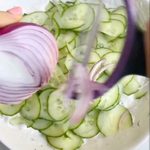How to Cook Garlic Scapes to Upgrade Your Summer Dinners

Once you know how to cook garlic scapes, you'll join the club of those who celebrate their short season every year!
For years, I ran a farm-to-table restaurant that sourced the majority of its produce from local farms. My favorite time of the year was spring. The appearance of stinging nettles, fiddlehead ferns and morel mushrooms were a welcome sign that winter was finally over! As we worked our way through spring vegetables, we waited with eager anticipation for late spring or early summer when garlic scapes came in.
Once you know how to cook garlic scapes, you’ll join in the excitement. They’re rarely available at the grocery store, so you’ll want to keep an eye out at your local farmers market. Garlic scapes are a by-product of growing hardneck garlic, and this flowering stem is only available for a few weeks, so you’ll want to take advantage when you can.
How to Prepare Garlic Scapes
While the whole garlic scape is edible, many people remove the flower bulb at the end before cooking. It has a thinner texture and can cook at a different rate than the rest of the stem. At the very least, you’ll want to cut off the top inch (which is very, very thin).
If the scapes have been on the plant for a long time, the bottom stem may become tough. You’ll know if this is the case if it feels fibrous or excessively chewy when you give it a nibble. You can snap the bottoms off where you notice the stem stiffen (just like asparagus). Instead of throwing the tough stems away, use them like a bay leaf and simmer them whole in soups or stews, removing the stem before eating.
How to Cook Garlic Scapes
Saute
I generally like to cut garlic scapes into small pieces before sauteing or stir-frying. Depending on the dish and your preferences, the chopped bits can look like tiny coins or as pieces as large as 2 inches.
Once you’ve decided on the size, heat a tablespoon or so of butter or oil in a large skillet over medium-high heat. Add the chopped scapes and cook for 3 to five 5, stirring occasionally, until they’re browned and tender. For extra tender scapes, add a splash of water, cover the pan and cook for an additional 2 to 3 minutes.
Depending on your application, you can season the scapes simply with salt and pepper or add flavorings like soy sauce, vinegar, chopped herbs or roasted garlic.
Use sauteed scapes as a pizza topping, toss them with pasta, use them as a garnish for grits or swirl them into frittatas and other egg dishes.
Grill
If you love cooking with a grill, you’re in luck. Grilled garlic scapes are one of the best ways to prepare this seasonal delicacy. The grill allows the scapes to retain their crisp texture, and the addition of a light char deepens their sweet flavor. I like to keep the scapes whole and chop them after cooking to minimize the chances they’ll fall through the grill grates.
Toss the scapes with a little olive oil and salt, and add them to a grill preheated for medium-high heat. Cook the scapes for a few minutes per side, flipping them over when you notice lightly charred spots. The scapes should be bright green and tender in texture when finished.
Enjoy grilled garlic scapes with other grilled vegetables like zucchini, summer squash, peppers or eggplants. They also make a great addition to vegetable platters with crudite dip or as an addition to salads or grain bowls
Pickle
If you end up with more scapes than you know what to do with, pickle them! You can cut the scapes into sticks that fit in a pickling jar or you can pickle them whole, taking advantage of their curly shape to pack the jar full. Prepare a brine of vinegar, water, salt, sugar and your favorite spices. I generally like a 3% brine here (using 2 tablespoons salt per 5 cups of liquid), but any pickled vegetable recipe works.
Pickled scapes bring a fantastic brightness to salads or roasted vegetable dishes, and they’re a stand-out accouterment on charcuterie boards.
Blend into pesto sauce, vinaigrette or dressing
Garlic scapes can be fibrous (especially those tough ends), but they blend into a smooth paste when whizzed in a food processor or blender. Start by blending garlic scapes on their own to break them down as much as possible. Then, add your favorite additions (like nuts and cheese to make pesto or oil and vinegar for dressings).
Use the blended garlic scapes as a marinade or instead of garlic cloves in your favorite vinaigrette. A favorite springtime dressing, green goddess salad dressing, can be made with garlic scapes to create a stand-out flavor. Here are a few tips for making garlic scape pesto.
Chop into butter
Homemade butter is an easy way to amp up the flavor of any dish. To make garlic scape compound butter, pulse a cup of scapes in the food processor and fold them into a cup of softened butter. Add other herbs and flavorings as desired, like parsley, lemon juice or Worcestershire. Roll the butter into a log on parchment paper and store it in the freezer for up to three months.
Garlic scape herbed butter is light but bright, making it perfect for pairing with a light fish in the summertime. We also love it melted over a pan of roasted vegetables, tossed with pasta or served on top of grilled steak or pork chops.
Can You Substitute a Garlic Scape for a Clove of Garlic?
When they’re in season, feel free to use garlic scapes in any recipe that calls for garlic cloves. Garlic scapes aren’t as pungent as garlic cloves, but they have the same aroma and a similar flavor profile. Use one scape for every clove of garlic called for in the original recipe.
Are Garlic Scapes Better Raw or Cooked?
Garlic scapes can be eaten raw, but it’s not my favorite eating experience. They have a nice flavor, but the texture is quite fibrous. If you do choose to eat raw garlic scapes, slice them very thin or break down the tough fibers by pulsing them in the food processor.
Garlic scapes are perfect for these recipes for garlic lovers.




